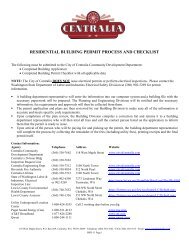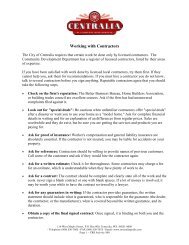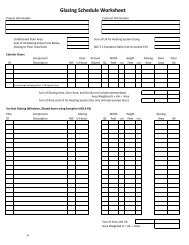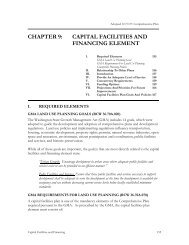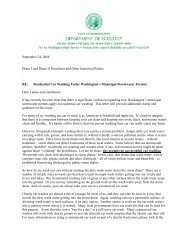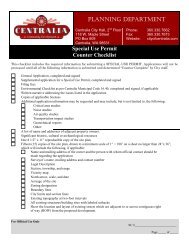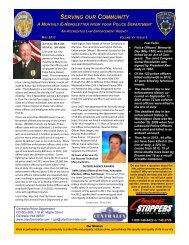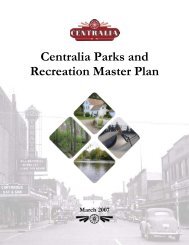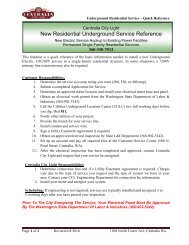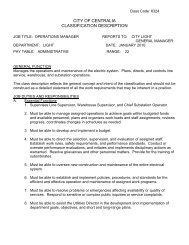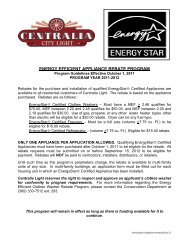GeoTech Report - City of Centralia
GeoTech Report - City of Centralia
GeoTech Report - City of Centralia
- No tags were found...
Create successful ePaper yourself
Turn your PDF publications into a flip-book with our unique Google optimized e-Paper software.
LEWIS COUNTY EVENT CENTER & SPORTS COMPLEX • <strong>Centralia</strong>, WashingtonFILL PLACEMENT AND COMPACTION CRITERIA. Structural fill should be mechanically compacted to a firmand unyielding condition. Structural fill should be placed in loose lifts not exceeding 8 to 10 inchesin thickness. Each lift should be conditioned to the proper moisture content and compacted to thespecified density before placing subsequent lifts. Structural fill should be compacted to thefollowing criteria:■ Structural fill placed below floor slabs and footings should be compacted to 95 percent <strong>of</strong> theMDD estimated in general accordance with ASTM D 1557.■ Structural fill in conventional pavement areas, including utility trench backfill, should becompacted to 90 percent <strong>of</strong> the MDD estimated in general accordance with ASTM D 1557,except that the upper 2 feet <strong>of</strong> fill below final subgrade should be compacted to 95 percent <strong>of</strong>the MDD.■ Structural fill placed as crushed rock base course below conventional pavements should becompacted to 95 percent <strong>of</strong> the MDD estimated in general accordance with ASTM D 1557.■ Structural fill below permeable pavement areas should be compacted to 85 to 90 percent <strong>of</strong>the MDD (ASTM D 1557) to maintain void space for infiltration and drainage.We recommend that a geotechnical engineer be present during pro<strong>of</strong>-rolling and/or probing <strong>of</strong> theexposed subgrade soils, and during placement <strong>of</strong> structural fill. The geotechnical engineer shouldevaluate the adequacy <strong>of</strong> the subgrade soils and identify areas needing further work, perform inplacemoisture-density tests in the fill to evaluate whether the work is being done in accordancewith the compaction specifications, and advise on any modifications to procedures that may beappropriate for the prevailing conditions.WEATHER CONSIDERATIONS. The on-site soils generally contain a high percentage <strong>of</strong> fines (silt) andare moisture-sensitive, particularly those soils in the southern half <strong>of</strong> the site. When the moisturecontent <strong>of</strong> these soils is more than a few percent above the optimum moisture content, theybecome muddy and unstable. Operation <strong>of</strong> equipment in these conditions will be difficult, and therequired compaction criteria will not be achieved. Additionally, disturbance <strong>of</strong> near-surface soilsshould be expected if earthwork is completed during periods <strong>of</strong> wet weather. During dry weather,the soils will: (1) be less susceptible to disturbance; (2) provide better support for constructionequipment; and (3) be more likely to meet the required compaction criteria.The wet weather season in western Washington generally begins in October and continues throughMay; however, periods <strong>of</strong> wet weather may occur during any month <strong>of</strong> the year. If wet weatherearthwork is unavoidable, we recommend that the following steps be taken should thenear-surface soil conditions begin to deteriorate:■ The ground surface should be graded so that areas <strong>of</strong> ponded water do not develop.The contractor should take measures to prevent surface water from collecting in excavationsand trenches. Measures should be implemented to remove surface water from the work area.■ Earthwork activities should not take place during periods <strong>of</strong> heavy precipitation.■ The contractor should take necessary measures to prevent on-site soils and soils to be used asfill from becoming wet or unstable. These measures may include the use <strong>of</strong> plastic sheeting,sumps with pumps, and grading. The site soils should not be left uncompacted and exposed toMay 7, 2010 | Page 11File No. 1985-021-00



